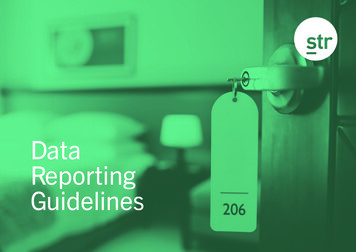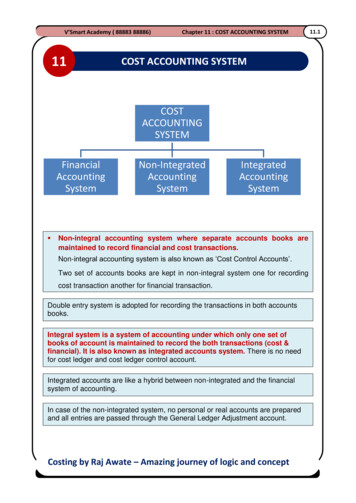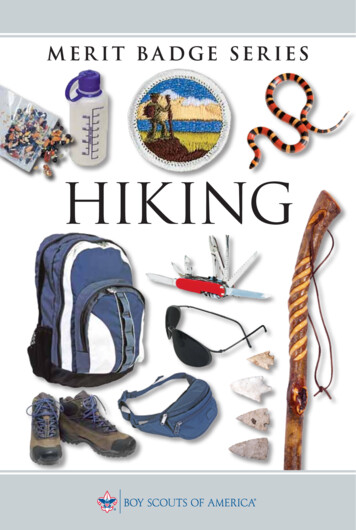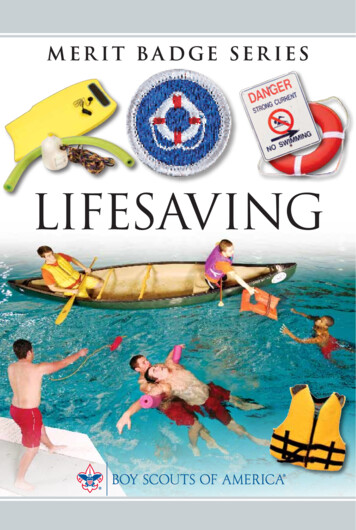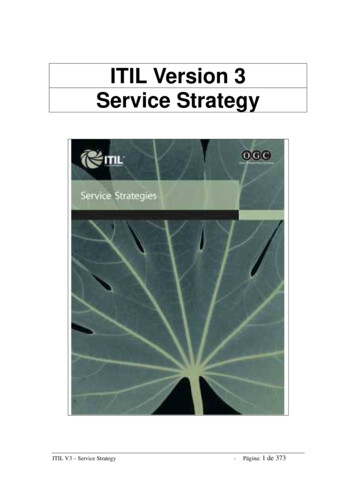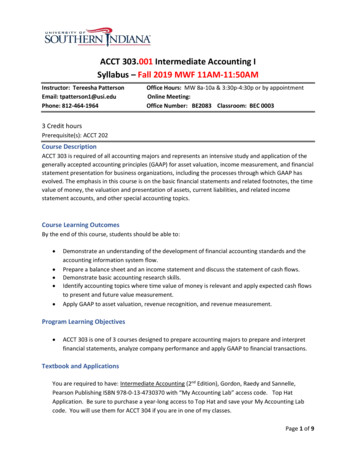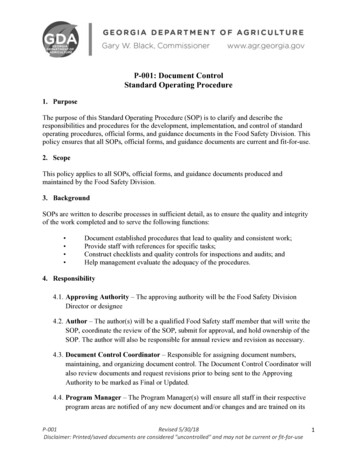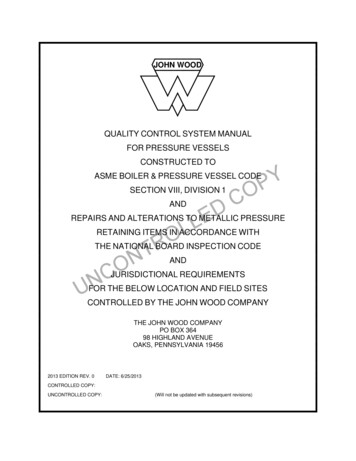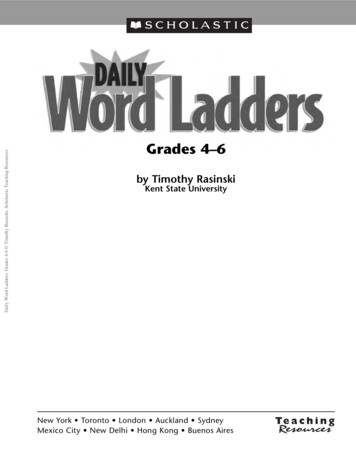
Transcription
Daily Word Ladders: Grades 4-6 Timothy Rasinski, Scholastic Teaching ResourcesGrades 4–6by Timothy RasinskiKent State UniversityNew York Toronto London Auckland SydneyMexico City New Delhi Hong Kong Buenos Aires
To my own children—Mike, Emily, Mary, and Jenny—Word Wizards in their own right.A father couldn’t ask for better kids.Daily Word Ladders: Grades 4-6 Timothy Rasinski, Scholastic Teaching ResourcesScholastic Inc. grants teachers permission to photocopy the reproducible pages inthis book for classroom use. No other part of this publication may be reproduced inwhole or in part, or stored in a retrieval system, or transmitted in any form or byany means, electronic, mechanical, photocopying, recording, or otherwise, withoutwritten permission of the publisher. For information regarding permission, write toPermissions, Scholastic Inc., 557 Broadway, New York, NY 10012.Cover design by Maria LiljaInterior design by Ellen Matlach for Boultinghouse & Boultinghouse, Inc.Interior illustrations by Teresa AnderkoISBN: 0-439-77345-8Copyright 2005 by Timothy RasinskiAll rights reserved. Printed in the U.S.A.1 2 3 4 5 6 7 8 9 104013 12 11 10 09 08 07 06 05
Daily Word Ladders: Grades 4-6 Timothy Rasinski, Scholastic Teaching ResourcesContentsWelcome to Word Ladders! . . . 5All in the Family . . . . . . . . . . . . . . 33Eat Your Vegetables . . . . . . . . . . . . 7Give a Dog a Bone. . . . . . . . . . . . 34Money Matters . . . . . . . . . . . . . . . 8Dinner’s Ready . . . . . . . . . . . . . . . 35Outerwear . . . . . . . . . . . . . . . . . . . 9Happy Birthday . . . . . . . . . . . . . . 36Behind the Wheel . . . . . . . . . . . . 10Chew on This. . . . . . . . . . . . . . . . 37Give a Little . . . . . . . . . . . . . . . . . 11Peaks and Valleys . . . . . . . . . . . . . 38Things That Go Bumpin the Night . . . . . . . . . . . . . . . . . 12A Rose Is a Rose . . . . . . . . . . . . . . 39Toothsome. . . . . . . . . . . . . . . . . . 13Say Cheese . . . . . . . . . . . . . . . . . 14Hat Head . . . . . . . . . . . . . . . . . . . 15In the Money . . . . . . . . . . . . . . . . 16Meet and Greet . . . . . . . . . . . . . . 17Cool Drinks . . . . . . . . . . . . . . . . . 18Stars and Stripes . . . . . . . . . . . . . 19In My Room. . . . . . . . . . . . . . . . . 20Sleepytime . . . . . . . . . . . . . . . . . . 21Giving Thanks . . . . . . . . . . . . . . . 22Express Mail. . . . . . . . . . . . . . . . . 23Stormy Days . . . . . . . . . . . . . . . . 24Official Officers . . . . . . . . . . . . . . 25Bucket Brigade. . . . . . . . . . . . . . . 26Sweet Things . . . . . . . . . . . . . . . . 27Here to There. . . . . . . . . . . . . . . . 28Good Eating. . . . . . . . . . . . . . . . . 29That’s Entertainment . . . . . . . . . . 30All Is Forgiven . . . . . . . . . . . . . . . 31Go, Go, Go . . . . . . . . . . . . . . . . . 32Childhood . . . . . . . . . . . . . . . . . . 40Cheese Eaters. . . . . . . . . . . . . . . . 41Frosty Fun . . . . . . . . . . . . . . . . . . 42Seaworthy . . . . . . . . . . . . . . . . . . 43Sew Sew . . . . . . . . . . . . . . . . . . . 44Save Your Pennies . . . . . . . . . . . . 45Right or Wrong . . . . . . . . . . . . . . 46Precipitation Puzzle . . . . . . . . . . . 47Snow Day . . . . . . . . . . . . . . . . . . 48Winter Wear. . . . . . . . . . . . . . . . . 49Out of This World . . . . . . . . . . . . 50Fried Snacks . . . . . . . . . . . . . . . . . 51Candlelight . . . . . . . . . . . . . . . . . 52Car Trouble . . . . . . . . . . . . . . . . . 53Play Date . . . . . . . . . . . . . . . . . . . 54Beautiful Day . . . . . . . . . . . . . . . . 55Ruling the Roost . . . . . . . . . . . . . 56New and Not-So-New . . . . . . . . . 57Midday Meal . . . . . . . . . . . . . . . . 58Growing Up. . . . . . . . . . . . . . . . . 59Wedding Words . . . . . . . . . . . . . . 60
Fish Wish . . . . . . . . . . . . . . . . . . . 89Rub-a-Dub-Dub . . . . . . . . . . . . . . 62From the Ground Up . . . . . . . . . . 90Underwater . . . . . . . . . . . . . . . . . 63Strength Training . . . . . . . . . . . . . 91Hear This . . . . . . . . . . . . . . . . . . . 64Getting the Message . . . . . . . . . . 92Brainy Birds . . . . . . . . . . . . . . . . . 65Medal Winners. . . . . . . . . . . . . . . 93Itchy and Scratchy . . . . . . . . . . . . 66Fading Light. . . . . . . . . . . . . . . . . 94Drinking Vessels . . . . . . . . . . . . . . 67Auto Adventures . . . . . . . . . . . . . 95Good Books . . . . . . . . . . . . . . . . . 68Where the Heart Is . . . . . . . . . . . . 96Land of the Free. . . . . . . . . . . . . . 69Quick Wit. . . . . . . . . . . . . . . . . . . 97Corny! . . . . . . . . . . . . . . . . . . . . . 70My Family . . . . . . . . . . . . . . . . . . 98School Days . . . . . . . . . . . . . . . . . 71Family Ties . . . . . . . . . . . . . . . . . . 99Jobs for Grownups . . . . . . . . . . . . 72Greener Pastures . . . . . . . . . . . . 100Ship Shape. . . . . . . . . . . . . . . . . . 73Fur Facts . . . . . . . . . . . . . . . . . . 101Suppertime . . . . . . . . . . . . . . . . . 74Woody Wonder . . . . . . . . . . . . . 102Just a Spoonful. . . . . . . . . . . . . . . 75Mind Your Manners . . . . . . . . . . 103Flower Power . . . . . . . . . . . . . . . . 76And the Winner Is . . . . . . . . . . 10424 Hours . . . . . . . . . . . . . . . . . . . 77Dressing Up . . . . . . . . . . . . . . . . 105Horse Sense . . . . . . . . . . . . . . . . . 78Directions . . . . . . . . . . . . . . . . . 106Voting Booth . . . . . . . . . . . . . . . . 79Get Well Soon . . . . . . . . . . . . . . 107Sailing . . . . . . . . . . . . . . . . . . . . . 80Answer Key . . . . . . . . . . . . . . . 108Bunny Tales . . . . . . . . . . . . . . . . . 81Good Hare Day . . . . . . . . . . . . . . 82Very Fishy. . . . . . . . . . . . . . . . . . . 83Beasts of Burden . . . . . . . . . . . . . 84Apple for Teacher. . . . . . . . . . . . . 85Art Smart . . . . . . . . . . . . . . . . . . . 86Uphill . . . . . . . . . . . . . . . . . . . . . . 87Globe Guessing . . . . . . . . . . . . . . 88Daily Word Ladders: Grades 4-6 Timothy Rasinski, Scholastic Teaching ResourcesFriendship . . . . . . . . . . . . . . . . . . 61
Daily Word Ladders: Grades 4-6 Timothy Rasinski, Scholastic Teaching ResourcesWelcome to Word Ladders!In this book you’ll find 100 mini-wordstudy lessons that are also kid-pleasinggames! To complete each Word Laddertakes just ten minutes but actively involveseach learner in analyzing the structure andmeaning of words. To play, students beginwith one word and then make a series ofother words by changing or rearranging theletters in the word before. With regular use,Word Ladders can go a long way towarddeveloping your students’ decoding andvocabulary skills.that all children need to perform in orderto learn how to decode and spellaccurately. And when the puzzle adds a bitof meaning in the form of a definition (forexample, “make a word that means to saysomething”), it helps extend students’understanding of words and concepts.All of these skills are key to students’success in learning to read and write. Soeven though Word Ladders will feel likea game, your students will be practicingessential literacy skills at the same time!How do Word Ladders work?Let’s say our first Word Ladder begins withthe word walk. The directions will tellstudents to change one letter in walk tomake a word that means “to speak.” Theword students will make, of course, is talk.The next word will then ask students tomake a change in talk to form anotherword—perhaps chalk, or tall. At the top ofthe ladder, students will have a final wordthat is in some way related to the firstword—for example, run. If students getstuck on a rung along the way, they cancome back to it, because the words beforeand after will give them the clues theyneed to go on.How do Word Ladders benefitstudents?Word Ladders are great for buildingstudents’ decoding, phonics, spelling, andvocabulary skills. When students add orrearrange letters to make a new wordfrom one they have just made, they mustexamine sound-symbol relationshipsclosely. This is just the kind of analysisNameRead the clues, then writethe words.Start at the bottom andclimb to the top.r ad i s h10A plate on whichfood is eaten.Change one letter.di shda s h8To cut with big,sweeping strokes.Change one letter.s l ash654s t abA large, flat, often thickpiece of something.Change one letter.3s t ab l e2A piece of furniture atwhich you eat meals.Take away four letters.To splash a liquid about.Take away one letter,then add two.s l obs l abTo wound or piercewith a pointed weapon.Take away two letters.A small amount ofsomething, like aseasoning for food.Take away two letters,then add one.7s l oshA very messy orslovenly person.Change one letter.A red-colored rootvegetable.Add two letters.9t ab l eA place to keep horses.Or steady.Add one letter.1v ege t ab l e7How do I teach a Word Ladder lesson?Word Ladders are incredibly easy and quickto implement. Here are four simple steps:1. Choose one of the 100 Word Ladders totry. (The last three pages are the hardestladders in the book, so avoid startingwith those.)2. Make a copy of the Word Ladder foreach student.3. Choose whether you want to do yourWord Ladders with the class as a whole,or by having students work alone, in5
pairs, or in groups. (You might do thefirst few together, until students areready to work more independently.)Look for the Bonus Boxes withstars. These are particularly difficultwords you may want to preteach.Or you can do these ladders as agroup so that children will not getstuck on this rung.That’s the lesson in a nutshell! It shouldtake no longer than ten minutes to do.Once you’re done, you may wish to extendthe lesson by having students sort thewords into various categories. This canhelp them deepen their understanding ofword relationships. For instance, theycould sort them into: Grammatical categories. (Which wordsare nouns? Verbs?) Word structure. (Which words have along vowel and which don’t? Whichcontain a consonant blend?) Word meaning. (Which words expresswhat a person can do or feel? Whichdo not?)6To give students extra help, mix upand write all the “answers” for theladder (that is, the words for eachrung) on the board for them to choosefrom as they go through the puzzle.In addition: Add your own clues to give studentsextra help as they work througheach rung of a ladder. A recent eventin your classroom or communitycould even inspire clues for words. If students are having difficulty witha particular word, you might simplysay the word aloud and see ifstudents can spell it correctly bymaking appropriate changes in theprevious word. Elaborate on themeanings of the words as studentsmove their way up the ladder. If students are stuck on a particularrung of the Word Ladder, tell themto skip it and come back to it later. Challenge students to come up withalternative definitions for the samewords. Many words, like lock, fall,and stock, have multiple meanings.Timothy Rasinski is a professor of literacyeducation at Kent State University, with aspecial focus on young and strugglingreaders. Dr. Rasinski has served on theboard of directors at the InternationalReading Association and as president of theCollege Reading Association. He is theauthor of numerous books and professionalarticles on effective reading instruction.Daily Word Ladders: Grades 4-6 Timothy Rasinski, Scholastic Teaching Resources4. At each new word, students will seetwo clues: the kinds of changes theyneed to make to the previous word(“rearrange the letters” or “add twoletters”), and a definition of or clue tothe meaning of the word. Sometimesthis clue will be a sentence in which theword is used in context but is left outfor children to fill in. Move from wordto word this way, up the whole WordLadder.Tips for WorkingWith Word Ladders
NameRead the clues, then write the words.Start at the bottom and climb to the top.Daily Word Ladders: Grades 4-6 Timothy Rasinski, Scholastic Teaching Resources10A plate on whichfood is eaten.Change one letter.98To cut with big,sweeping strokes.Change one letter.A large, flat, often thickpiece of something.Change one letter.32A piece of furniture atwhich you eat meals.Take away four letters.To splash a liquid about.Take away the lastletter, then add two.54To wound or pierce witha pointed weapon.Take away two letters.A small amount ofsomething, like aseasoning for food.Take away two letters,then add one.76A very messy orslovenly person.Change one letter.A red-colored rootvegetable.Add two letters.A place to keep horses.Or steady.Add one letter.1v ege t ab l e7
NameRead the clues, then write the words.Start at the bottom and climb to the top.What two nickels make.Change one letter.11Alike. These two thingsare almost the.Change one letter.98Mentally healthyor sound.Change one letter.To have sung in the past.Change one letter.76What a bee orwasp might do.Change one letter.54A light red color.Change one letter.1n i cke l8To be smelly.Take away one letter,then add two.32A small cucumber that hasbeen preserved in vinegar.Change one letter andrearrange the last two.To make music withyour mouth.Take away one letter.To choose.Take away two letters.Daily Word Ladders: Grades 4-6 Timothy Rasinski, Scholastic Teaching Resources10An old-fashionedword for woman.Change one letter.
NameRead the clues, then write the words.Start at the bottom and climb to the top.Daily Word Ladders: Grades 4-6 Timothy Rasinski, Scholastic Teaching Resources12be nimble,be quick.Change one letter.1110To write quickly.Change one letter.Number of cents in a dime.Take away four letters.32Perspiration.Take away two letters.A small rock.Add two letters.54To make sweet.Add two letters.This word makes astatement negative.Take away two letters.762,000 pounds.Change one letter.Slang for an athlete.Take away the lastletter, then add two.98What musicians readto play music.Rearrange the letters.Worn for warmth.Add two letters.Opposite o
How do Word Ladders work? Let’s say our first Word Ladder begins with the word walk. The directions will tell students to change one letter in walk to make a word that means “to speak.” The word students will make, of course, is talk. The next word will then ask students to make a change in talk to form another word—perhaps chalk, or tall. At the top of
